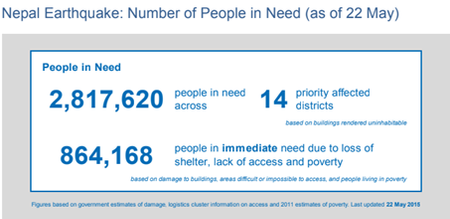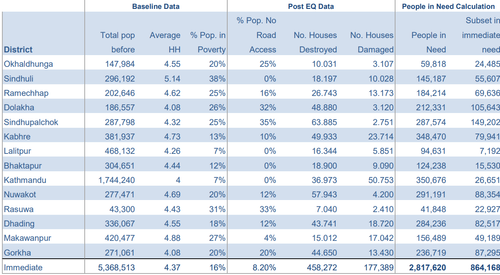Overview
...
What is are 'People in Need'?
The number of people in need of humanitarian assistance helps to define the magnitude of a crisis and the overall cost estimate of an emergency response; it is a prerequisite for strategic planning and response monitoring. Identifying the number of People in Need is also essential to determine priority areas for interventions, when those are defined as a function of people in need, access, and likely deterioration, etc. This section looks at specific examples and step-by-step approaches to derive estimates for the size of the population in need. It assumes that the Total Population, as well as the total number of People Affected (in accordance with the Humanitarian Profile), is known
...
- whose physical security, basic rights, dignity, living conditions or livelihoods are threatened or have been disrupted, AND
- whose current level of access to basic services, goods, and social protection is inadequate to re-establish normal living conditions with their accustomed means in a timely manner without additional assistance.
How to establish People in Need
...
The two main approaches to help identify PIN are the top-down and the bottom-up approach.
Top-Down Approach
There are two top-down approaches: 1) The Core Humanitarian Problem approach and 2) The Intensity of Needs approach.
1) The Core Humanitarian Problem Approach
In their simplest form, unmet needs can be measured in relation to a "core humanitarian problem". This approach is based on the premise that there is a common denominator of the population affected and in need, a "core problem" generated by the specific nature of the shock. For example, after a sudden-onset crisis such as an earthquake, food or tropical storm, the core problem and most relevant proxy indicator for people in need can be damage to shelter.
...
| Field Example: Libya Humanitarian Crisis 2015 | |
|---|---|
The Humanitarian Needs Overview 2015 in Libya used mostly the location and the humanitarian profile to identify the number of people in need in the country. 100% of IPDs, refugees and asylum seekers and migrants were considered in need of assistance. However, following a multisectoral assessment, approximately 640,000 residents affected were not considered in need of assistance and were discarded from this category. Furthermore, within the population in need, 1.35 million women and children were identified as vulnerable groups. Strengths The strength of this approach lies in its logical description of the population in need as a subset of the identified groups of the humanitarian profile. | |
2) The Intensity of Needs Approach
Beyond the binary distinction between people in need/not in need, PIN estimates can be further refined or graded using intensity categories. This distinction is particularly used in contexts that are a) protracted and complex; b) experience regular and intense shocks with a very unequal distribution of impact on the population, and c) require prioritization of resources or geographical targeting. This is well established in some cluster practice, for example, the nutrition sector with clearly set thresholds reflecting different and mutually exclusive levels of malnutrition. Working with intensity levels calls for either developing complex composite measures, or using context adapted scales with clear definitions for each gradation, such as the Integrated Phase Classification (IPC) reference table for food security.
...
| Field Example: Nepal Humanitarian Crisis 2015 | |
|---|---|
The Assessment Unit in Nepal worked with the census, damage, vulnerability and access data to define the overall PIN. In their approach, they distinguished between people in need, defined as those who require assistance to be able to rebuild their lives, and people in immediate need due to “loss of shelter, lack of access to essential services and poverty”. The methodology used government statistics of fully and partially damaged houses (houses that cannot be repaired vs houses which are repairable) multiplied by the average household size, overlaid with poverty statistics and road access information. For areas without road accessibility, households with fully and partially damaged houses were all considered in need of immediate assistance, regardless of the poverty threshold, as they were expected to face significant logistical challenges to rebuild their houses during the monsoon. For areas where there was road access, fully and partially damaged households were considered in need of immediate assistance if they were below the poverty line in that district. The affected population was considered to have the most limited capacity to recover from earthquake losses due to their pre-existing financial circumstances and their location. People In Need =(Fully damaged households + Partially damaged households) x Average Household Size People in Immediate Need= PIN x ( Population in Poverty% + Population with no Road Access%) Limitations The limitations of this methodology include the assumption of a uniform impact of destruction on people above and below the poverty line. Poverty may be correlated both with lower impact- as low-rise housing less is likely to be destroyed or easier to rebuild- or higher impact, given a lack of resources to rebuild, repair or resupply. For more information please see the Nepal Earthquake: Number of People in Need. | |
Bottom-Up Approach
The bottom-up approach is used where estimates of population in need are already available but an overall PIN figure still needs to be agreed upon. The bottom-up approach consists of several aggregation rules, which if followed, will eliminate overlap and produce a best estimate of the overall, inter-sectoral number of People in Need.
...
Disaggregation by setting (urban/rural), sex and age, socioeconomic status, religion, ethnicity, etc. is less frequent but often required.
Aggregation Rules for the Bottom-Up Approach
Careful attention should be given when aggregating population figures across sectors, geographical area or affected groups. There are several aggregation rules that should be followed to avoid overlap and double counting to produce a best estimate of the overall, inter-sectoral number of People in Need.
...
Explain your methods no matter how crude or sophisticated. Consumers of the figures need to know and potentially repeat the method and get the same result. In explaining your methods also note the limitations and uncertainties and where figures have been approximated.
Resources
...
Humanitarian Profile Support Guidance 2016
...


